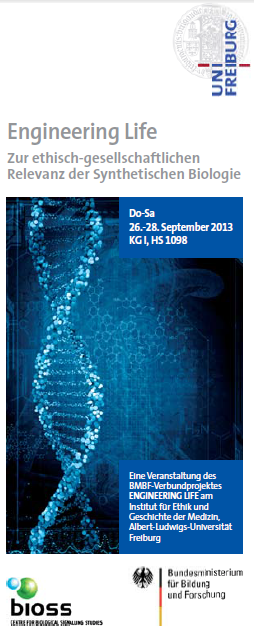Team:Freiburg/Safety/engineering life
From 2013.igem.org
| Line 139: | Line 139: | ||
</tr> | </tr> | ||
<tr> | <tr> | ||
| - | <td> <b>Figure | + | <td> <b>Figure 4: Poster Presentation </b><br> |
uniCas - The Toolkit for Gene Regulation | uniCas - The Toolkit for Gene Regulation | ||
</td> | </td> | ||
Revision as of 18:53, 30 September 2013

Engineering Life:
To the ethical and societal relevance of synthetic biology
In the end of September we participated at this seminar at the Institute for Ethics and History of Medicine of the University of Freiburg. It was the last session in a variety of meetings during 3 years. All meetings were gathered in the project with the topic Engineering Life: An interdisciplinary approach to the ethics of synthetic biology .
Here, different institutions investigated in the field of synthetic biology with the aim to clarify
a) if it is justified to speak about creating life,
b) how the reproach against science to "play God" could theologically be interpreted,
c) how risks and chances of this field of research shall be analyzed,
d) if the legal regulations were appropriate,
e) if there is a divergence in the systematical conditioning and actual research in synthetic biology.
During the last seminar from 26-28/9/2013 these questions arose again and again.
On 26/9/13 it was discussed how a future society based on biotechnology could look like.
Therefore, several movies from the Bio-Fiction film festival in Vienna were shown, where artists and filmmakers should visualize their associations with synthetic biology.
Here, the panel discussion came to the result, that many of the movies showed the chances but also the risks of synthetic biology. Some aspects of mythology reappeared in the movies e.g. breathe life into a golem or opening Pandora's box .
In general, the risks always seemed to have a stronger effect on the audience than the benefits had. Furthermore, synthetic biology seemed to be connected with some kind of industrialization and a symbiosis of nature and technology.
On 27/9/13 genetically engineered machines were in the focus of the curriculum. Thus, central questions arose e.g.
Living machines - a contradiction?
'Creating life! - Playing God?'
With these questions in mind the discussion went into a direction, where the role and the character of human beings was exposed in the light of synthetic biology. It was realized that within synthetic biology homo faber, a human that changes and modifies his environment, evolved to homo creator, a human that creates his environment anew.
This led automatically to the question if we would be in need of new laws and limits in order to safe the original environment and to beware the society from a next generation of bioweapons. This was the main topic of the last day of the seminar on 28/9/13.
Here, the panel discussion showed that differences in e.g. European and US-law make it difficult to assure the safety of the environment. Therefore, it was expressed that a global gremium should adjust international laws concerning biotechnology and synthetic biology. This was already done concerning dual-use debates and after a moratorium of several scientists that were working with so called superviruses in 2012, where a Global Health Security Policy Board additionaly to the NSABB was recommended.
"While biosafety measures aim to prevent the unintentional exposure to pathogens and toxins, or their accidental release, biosecurity
measures focus on the prevention of theft, misuse, or intentional release
of pathogens and toxins." [1]
Hence, a debate about Do it yourself biology and so called biohackers was initiated. The participants of the seminar submitted that these amateur biologists wouldn't represent any prior hazard to biosecurity as the access to laboratory devices is still expensive and difficult and the know-how not accesable enough. Further, it was considered that biohackers would risk their own health as they would work in inappropriate locations as private appartments. Thus, biohackers were categorized to biosafety affairs.
Concerning bioweapons and bioterrorism states and criminal organizations came in the focus of the talks.
iGEM was also mentioned several times during the whole seminar. It was described as a competition for young scientists where they can make their first experiences with the synthesis of systems. As our team participated on this seminar, we took the chance and presented our project in a poster session. Philosophers, theologists, bioethicists and scientists were interested in our presentation and asked completely different questions to our project. Interestingly, most of them knew CRISPR/Cas and other systems for gene regulation. Their questions were e.g.
a) if we were able to regulate endogenous genes ,
b) if we had implemented our uniCas-toolkit into a stable cell line or into a model organism as mus musculus,
c) if we had any idea to increase biosafety or biosecurity concerning our project?
Here, we could indicate on our #########################(link zur Seite mit manual? 2 plasmide etc.)####################### and explain our thoughts about risks and chances of a standardized CRISPR toolkit.
 |
| Figure 1: Engineering Life Seminar Flyer |
 |
| Figure 2: Golem and Löw Painting of Mikolas Ales, 1899 |
 |
| Figure 3: Poster Presentation uniCas - The Toolkit for Gene Regulation |
 |
| Figure 4: Poster Presentation uniCas - The Toolkit for Gene Regulation |
References
 "
"


